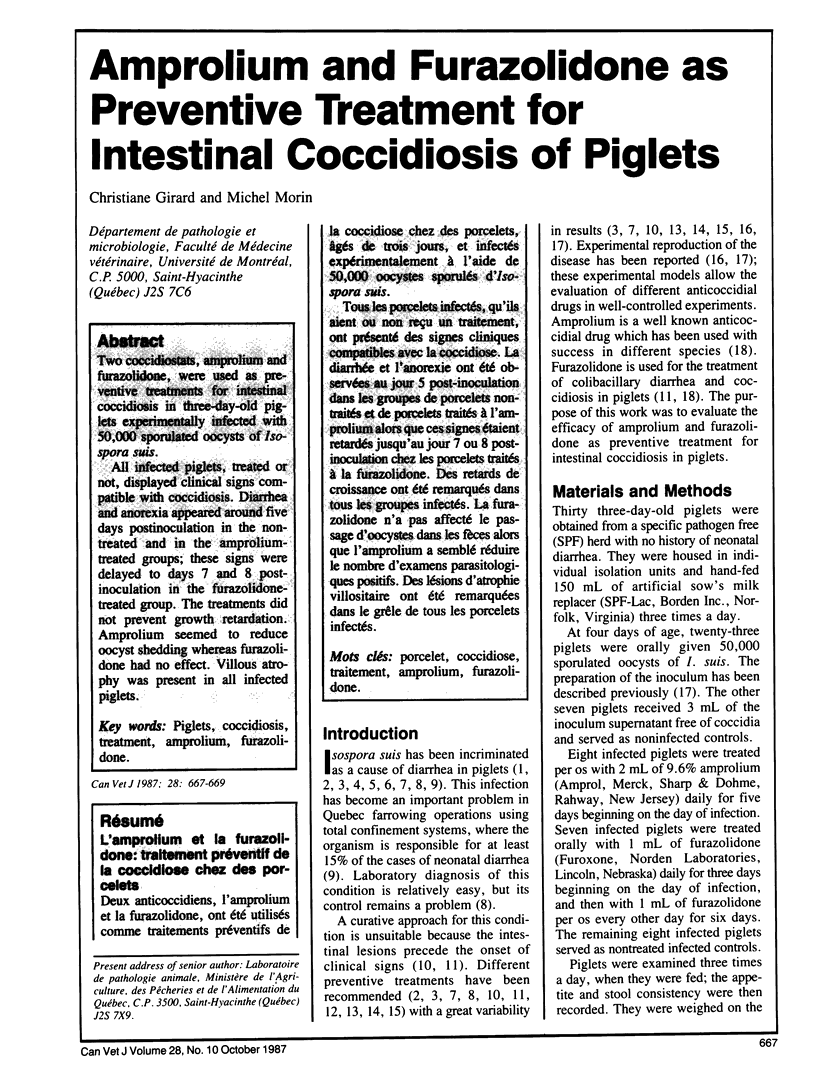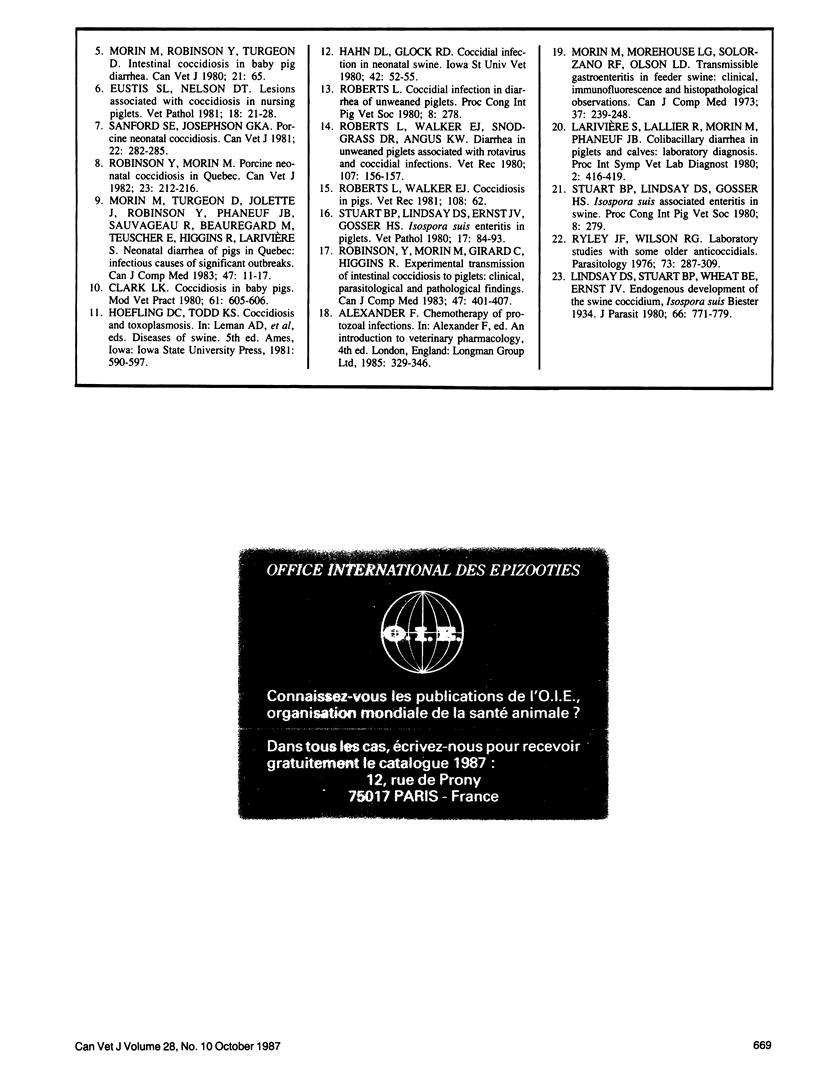Abstract
Two coccidiostats, amprolium and furazolidone, were used as preventive treatments for intestinal coccidiosis in three-day-old piglets experimentally infected with 50,000 sporulated oocysts of Isospora suis.
All infected piglets, treated or not, displayed clinical signs compatible with coccidiosis. Diarrhea and anorexia appeared around five days postinoculation in the non-treated and in the amprolium-treated groups; these signs were delayed to days 7 and 8 postinoculation in the furazolidone-treated group. The treatments did not prevent growth retardation. Amprolium seemed to reduce oocyst shedding whereas furazolidone had no effect. Villous atrophy was present in all infected piglets.
Keywords: Piglets, coccidiosis, treatment, amprolium, furazolidone
Full text
PDF


Selected References
These references are in PubMed. This may not be the complete list of references from this article.
- Clark L. K. Coccidiosis in baby pigs. Mod Vet Pract. 1980 Jul;61(7):605–606. [PubMed] [Google Scholar]
- Eustis S. L., Nelson D. T. Lesions associated with coccidiosis in nursing piglets. Vet Pathol. 1981 Jan;18(1):21–28. doi: 10.1177/030098588101800103. [DOI] [PubMed] [Google Scholar]
- Lindsay D. S., Stuart B. P., Wheat B. E., Ernst J. V. Endogenous development of the swine coccidium, Isospora suis Biester 1934. J Parasitol. 1980 Oct;66(5):771–779. [PubMed] [Google Scholar]
- Morin M., Morehouse L. G., Solorzano R. F., Olson L. D. Transmissible gastroenteritis in feeder swine: clinical, immunofluorescence and histopathological obervations. Can J Comp Med. 1973 Jul;37(3):239–248. [PMC free article] [PubMed] [Google Scholar]
- Morin M., Turgeon D., Jolette J., Robinson Y., Phaneuf J. B., Sauvageau R., Beauregard M., Teuscher E., Higgins R., Larivière S. Neonatal diarrhea of pigs in Quebec: infectious causes of significant outbreaks. Can J Comp Med. 1983 Jan;47(1):11–17. [PMC free article] [PubMed] [Google Scholar]
- Roberts L., Walker E. J. Coccidiosis in pigs. Vet Rec. 1981 Jan 17;108(3):62–62. doi: 10.1136/vr.108.3.62. [DOI] [PubMed] [Google Scholar]
- Roberts L., Walker E. J., Snodgrass D. R., Angus K. W. Diarrhoea in unweaned piglets associated with rotavirus and coccidial infections. Vet Rec. 1980 Aug 16;107(7):156–157. doi: 10.1136/vr.107.7.156. [DOI] [PubMed] [Google Scholar]
- Robinson M. M., Turgeon D. Intestinal coccidiosis in baby pig diarrhea. Can Vet J. 1980 Feb;21(2):65–65. [PMC free article] [PubMed] [Google Scholar]
- Robinson Y., Morin M., Girard C., Higgins R. Experimental transmission of intestinal coccidiosis to piglets: clinical, parasitological and pathological findings. Can J Comp Med. 1983 Oct;47(4):401–407. [PMC free article] [PubMed] [Google Scholar]
- Robinson Y., Morin M. Porcine neonatal coccidiosis in quebec. Can Vet J. 1982 Jul;23(7):212–216. [PMC free article] [PubMed] [Google Scholar]
- Ryley J. F., Wilson R. G. Laboratory studies with some older anticoccidials. Parasitology. 1976 Dec;73(3):287–309. doi: 10.1017/s0031182000046989. [DOI] [PubMed] [Google Scholar]
- Sanford S. E., Josephson G. K. Porcine neonatal coccidiosis. Can Vet J. 1981 Sep;22(9):282–285. [PMC free article] [PubMed] [Google Scholar]
- Sangster L. T., Stuart B. P., Williams D. J., Bedell D. M. Coccidiosis associated with scours in baby pigs. Vet Med Small Anim Clin. 1978 Oct;73(10):1317–1319. [PubMed] [Google Scholar]
- Stuart B. P., Lindsay D. S., Ernst J. V., Gosser H. S. Isospora suis enteritis in piglets. Vet Pathol. 1980 Jan;17(1):84–93. doi: 10.1177/030098588001700109. [DOI] [PubMed] [Google Scholar]
- Stuart B. P., Lindsay D. Coccidial diarrhea in swine. J Am Vet Med Assoc. 1979 Aug 15;175(4):328–329. [PubMed] [Google Scholar]


